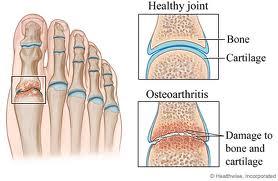There are over 140 different types of arthritis, the most common of which is Osteoarthritis. Another common form of arthritis we see as Podiatrists is Rheumatoid Arthritis.
What is Osteoarthritis?
Osteoarthritis (OA) affects 1 in 6 New Zealanders over 15 years old and commonly affects the joints in the feet and leg. OA has been called “wear and tear”or “degenerative” arthritis, it develops and progresses very slowly OA usually occurs in the hands and weight-bearing joints such as hips, knees, and feet.

In healthy joints, cartilage acts as a shock absorber and provides a smooth surface between the bones to facilitate easy movement. When a joint develops osteoarthritis the cartilage thins and becomes rough. In some cases the cartilage breaks down, leaving the bones unprotected and the joint loses its ability to move smoothly. The bones lose shape and thicken at the end, pieces of cartilage may break off and float around in the joint. This can disturb other soft tissue in the joint causing pain and swelling.
What is Rheumatoid Arthritis?
Rheumatoid arthritis (RA) is a form of inflammatory arthritis and an autoimmune disease. In RA the immune system attacks the body’s own tissues, specifically the synovium (a thin membrane that lines and lubricates the joints). As a result fluid builds up in the joints, causing pain and inflammation that’s systemic – meaning it can occur throughout the whole body.
Symptoms
Symptoms of RA vary from person to person and can change on a daily basis. Joints may feel warm to the touch and you might notice a decreased range of motion, as well as inflammation, swelling and pain in the areas around the affected joints. RA is symmetrical, meaning if a joint on one side of the body is affected, the corresponding joint on the other side of the body is also involved. Long term RA may cause damage to cartilage, tendons and ligaments – it can even wear away the ends of your bones. Some people with RA develop rheumatoid nodules; lumps of tissue that form under the skin, often over bony areas exposed to pressure such as your heels.
Treatment
Podiatry intervention in the initial stages of arthritis can slow down progression of bony deformities, with the use of an orthotic device and correct footwear we can encourage the foot and leg to function optimally and comfortably. If bony changes, areas of high pressure and restricted joints have already become an issue we can also help to reduce the discomfort associated with these.
Firstly, we will work with you to determine whether we are treating Rheumatoid or Osteoarthritis and try to unload the affected joint. This can be very successful, but the success of this depends on the degree of damage. In some cases an X-Ray may be required to assess the degree of joint damage as this provides us with the ability to be very specific around unloading the joint.

